
Last Updated on October 30, 2025 by David
Effective Techniques to Restore the Vibrancy of Faded Victorian Mosaic Tiles
- Victorian mosaic tiles frequently lose their colour due to the accumulation of ingrained dirt, outdated coatings, and surface wear, which are not solely due to their age.
- Harsh chemicals and aggressive scrubbing can strip away the original pigments, especially harmful to encaustic and geometric tiles.
- Safe restoration starts with a comprehensive deep cleaning process that employs pH-neutral solutions and low-speed rotary machines fitted with soft brushes.
- Outdated sealers and waxes must be carefully removed to reveal the true condition of the tile surface underneath.
- Colour enhancement is attainable through breathable, stone-safe sealants that enrich the tone without producing an undesired glossy sheen.
- Professional restoration can effectively revive original pigments without resorting to repainting or artificial colouring, thus preserving the tile’s authenticity.
- Maintaining restored tiles requires gentle cleaning practices and avoiding acidic or bleach-based products that could inflict damage.
- Heritage-sensitive methods ensure the preservation of both the aesthetic charm and historical importance of the tiles.
Mastering the Art of Restoring the Beauty of Victorian Tiles

Abbey Floor Care restoring the colour to a Victorian clay tile floor using a colour-enhancing impregnating sealer.
Victorian encaustic and mosaic tiles embody a vital element of British architectural heritage, renowned for their elaborate craftsmanship and unique colour palettes crafted from mineral pigments that are integrated directly into the clay tile bodies. These tiles not only elevate the aesthetic appeal of a space but also tell the historical story of their creation. Over time, however, these tiles can become dull and lack vibrancy due to surface wear, chemical interactions, and environmental factors. Restoring their original brilliance is a specialized endeavor that requires an in-depth understanding of the materials involved, historically accurate methods, and high-quality products that respect the integrity of the tiles.
Pro Tip: Essential Products for Daily Care of Victorian Tiles
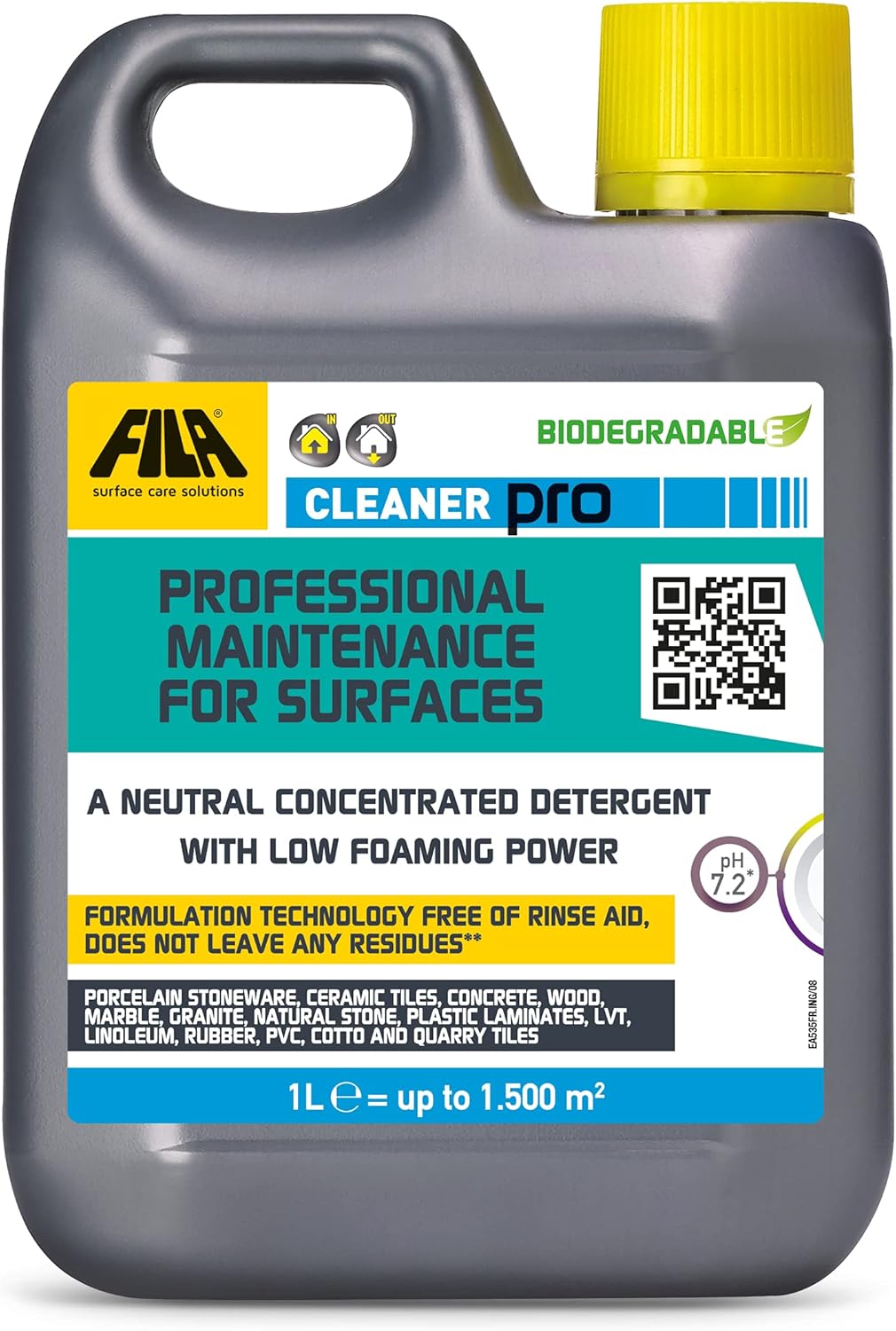
Fila Pro Floor Cleaner
|
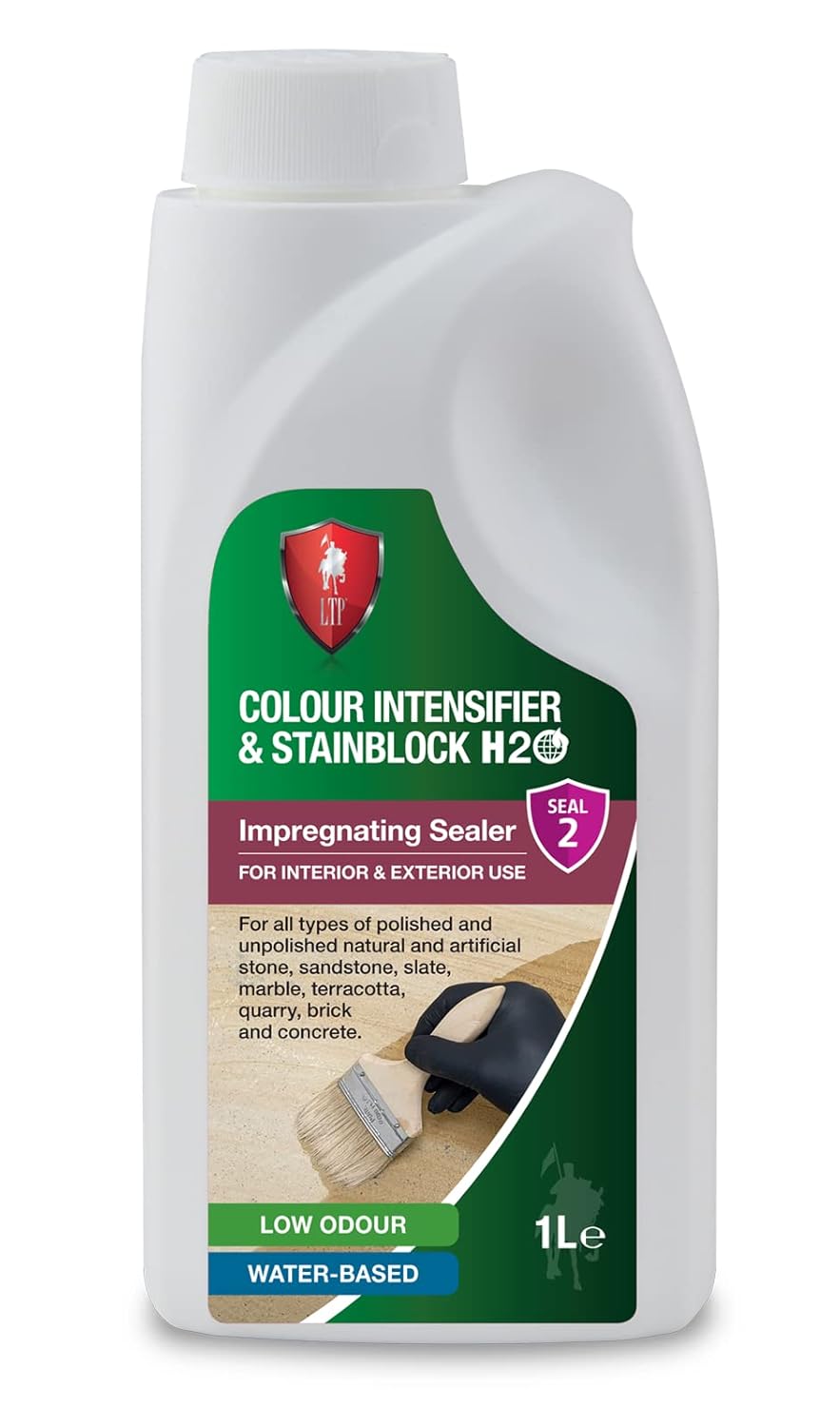
LTP Colour Intensifier & Stainblock H20
|
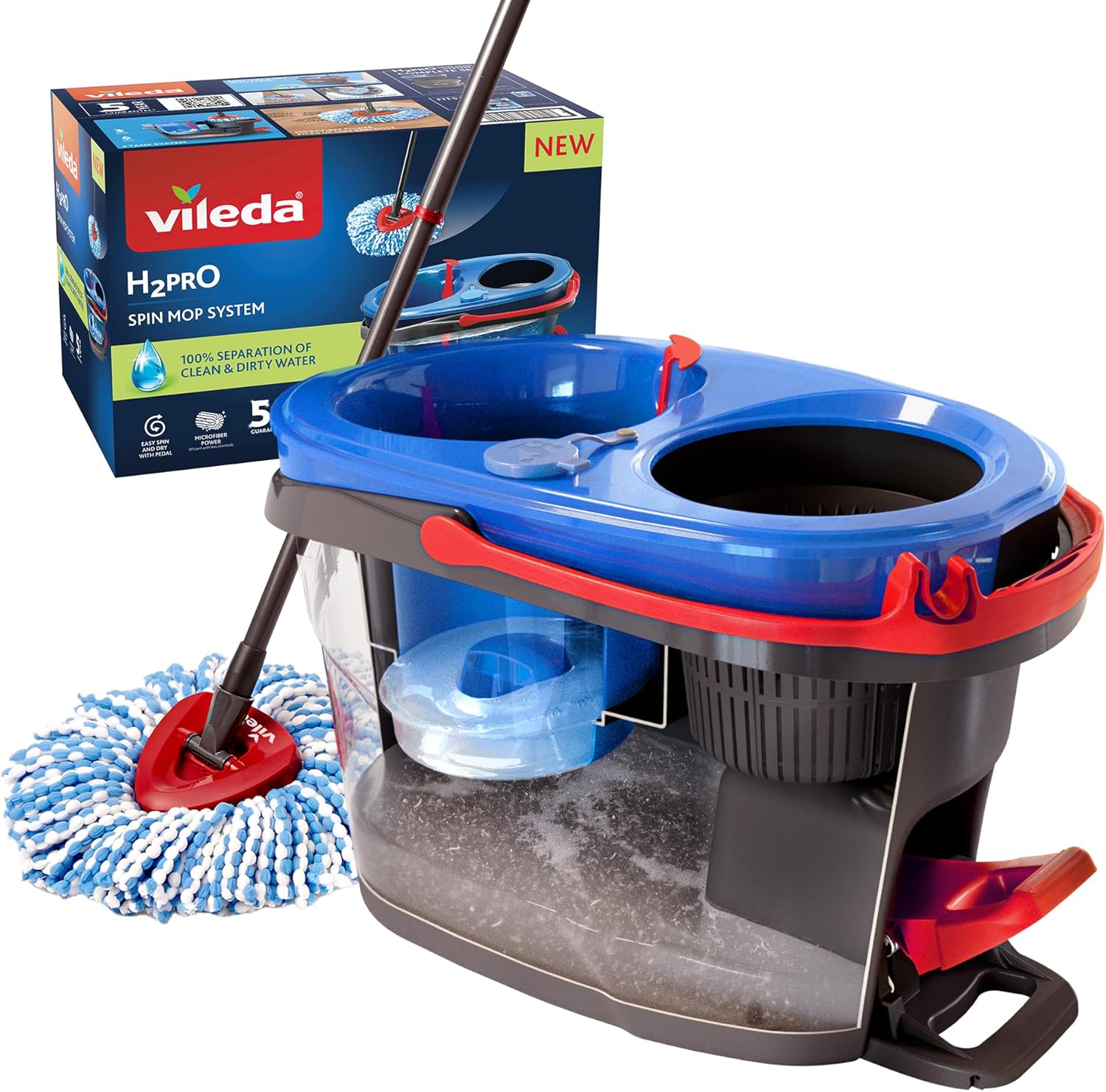
Vileda H2PrO Spin Mop System
|
As time passes, these tiles often suffer from a reduction in their visual impact due to surface wear, chemical effects, and environmental influences. Restoring their original vibrancy is a specialized task that necessitates a comprehensive understanding of the materials, historically accurate techniques, and premium products. Engaging professionals in tile restoration guarantees that the aesthetic beauty and historical integrity of these tiles are preserved, granting them a renewed life.
Identifying the Main Factors That Cause the Fading of Victorian Mosaic Tiles and Surface Dulling

Example of Victorian Clay Tile Floor dulled through surface wear and damage.
Despite the intrinsic nature of the pigments within the tile, various factors contribute to their fading and dulling. The main culprits include:
- Accumulated dirt and grime: Continuous foot traffic deposits fine particles and oils that infiltrate porous surfaces, scattering light and dulling colours, leading to a muted appearance.
- Wax and polish buildup: Layers of wax or sealants that fail to allow breathability can trap moisture, resulting in a cloudy or yellowed appearance that detracts from the visual attractiveness of the tiles.
- Moisture-driven issues: Many Victorian tiles were installed over subfloors without damp-proof membranes, resulting in rising damp that transports soluble salts, crystallizing on the tile surface as efflorescence, obscuring the original tones.
- Physical abrasion: Small surface scratches from years of wear disrupt smooth light reflection, diminishing visual richness and contributing to the overall dullness of the tiles.
Effective restoration addresses each of these factors meticulously without compromising the tile’s historic composition, ensuring that the original beauty is restored and preserved for future enjoyment.
Understanding the Importance of Breathability in the Absence of a Damp-Proof Membrane
Considering that many Victorian tiled floors rest on older subfloors lacking a damp-proof membrane (DPM), their natural clay structure must remain permeable to facilitate the evaporation of moisture from the subfloor. Non-breathable wax coatings or film-forming sealers block this evaporation pathway, leading to moisture accumulation beneath the surface. This entrapment can cause salts and humidity to form, resulting in efflorescence, degradation of surface minerals, and the unwanted phenomenon known as wax blooming—a whitish film or haze on the tile. Restoration strategies must prioritize breathable impregnating sealers that protect the tiles while allowing moisture vapour to escape freely, preventing long-term damage.
Comprehensive Analysis of Pigments and Tile Composition in Victorian Designs
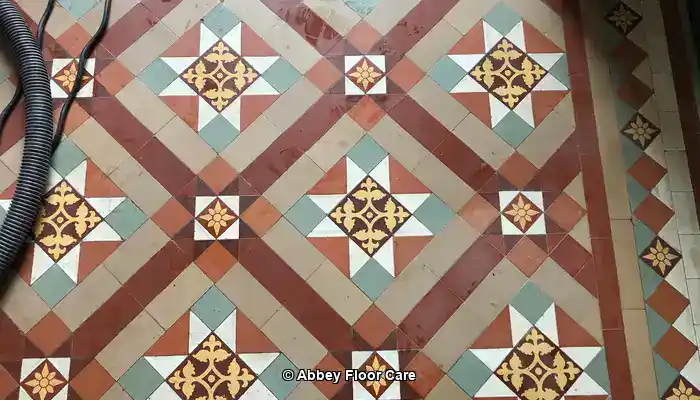
An example of different pigments in a Victorian Clay tile floor during restoration by Abbey Floor Care
Exploring the Function of Mineral Oxide Pigments in Victorian Tiles
Victorian mosaic and encaustic tiles derive their distinctive earthy colours from mineral oxide pigments embedded directly within the clay. These pigments contribute to both durability and depth of colour. The primary pigments include:
- Iron oxide: produces terracotta reds, rust browns, and soft ochres, enriching the distinctive palette of Victorian tile designs.
- Manganese: provides deep browns and rich blacks, enhancing the overall aesthetic appeal of the tiles.
- Cobalt: offers varying shades of blue, enhancing the vibrancy and richness of the tile colours.
- Chromium: yields natural green hues, popular in various tile patterns during the Victorian era.
Understanding the Firing and Fusion Process of Victorian Tiles
During manufacturing, the tiles undergo firing at temperatures around 1100°C, which vitrifies the clay and fuses the pigments deep into the tile body. This technique ensures that the colour permeates throughout the tile rather than simply adhering to the surface, thus offering enduring vibrancy and resistance to fading over time.
Characteristics and Significance of a Porous Unglazed Finish
Victorian tiles typically exhibit a porous, unglazed matte finish, creating a natural appearance. However, this porosity makes the tiles absorbent and vulnerable to surface contamination and moisture, necessitating careful cleaning and maintenance to uphold their integrity and beauty. Understanding this characteristic is essential for anyone involved in the care and restoration of these historic tiles.
Variability in Colour Durability Among Different Pigments
Natural earth pigments, particularly in red and yellow tiles, contain fewer mineral additives compared to darker colours like black, which are often formulated with manganese. This discrepancy translates to red and yellow tiles being less durable and more prone to surface dishing under heavy foot traffic. This wear manifests as shallow depressions where footfall is concentrated, causing uneven colour intensity and a noticeable loss of surface flatness that detracts from the overall appearance of the tiled surface.
Crucial Considerations for Restoration Projects
Comprehending pigment composition and tile wear patterns is vital in planning restoration efforts. Softer-toned tiles necessitate gentler cleaning methods and specialized impregnating sealers that respect their physical properties while enhancing colour. Conversely, darker, harder tiles can withstand more intensive cleaning but still require breathable, colour-enhancing protection to maintain vibrancy over time, ensuring their aesthetic appeal is preserved for future generations.
Specialized Cleaning Techniques for Restoring Victorian Mosaic Tiles
Effective cleaning is paramount in restoring Victorian encaustic and mosaic tiles to their original vibrancy. However, cleaning these tiles requires a specialized approach that goes beyond the use of standard pH-neutral detergents typically recommended. Professional restorers utilize specially formulated alkaline cleaners and mechanical techniques to break down heavy soiling and old residues without compromising the historic tile fabric. This meticulous approach ensures that the tiles are thoroughly cleaned while retaining their intrinsic beauty and character throughout the restoration process.
Meticulous Debris Removal: The Initial Stage of the Cleaning Process
The cleaning process commences with the meticulous removal of all loose dirt and grit using soft brushes or vacuuming with brush attachments. This step is crucial to prevent scratching the delicate tile surfaces during subsequent cleaning phases. Effectively eliminating debris sets the foundation for a successful and comprehensive cleaning process, ensuring that the tiles are treated with the utmost care.
Employing Alkaline Cleaners for Intensive Soil Removal
Unlike standard pH-neutral cleaners, which often lack the chemical strength to effectively tackle ingrained fatty acids and organic soils, alkaline cleaners are indispensable for thoroughly breaking down household oils, grease, and sticky residues commonly found on tile surfaces and within grout lines. These alkaline formulations dissolve the binding agents of dirt, sugars, and fats, facilitating effective removal while maintaining compatibility with the mineral composition of Victorian tiles. Professional-use alkaline products, such as PS87 PRO or custom formulations from heritage cleaning specialists, are typically used diluted to guarantee deep cleaning without overly aggressive action on the clay body. It is important to remember that, even with alkaline cleaners, caution is necessary, and spot testing is advised to avoid any adverse reactions during the cleaning process.
Mechanical Agitation with Appropriate Pads for Enhanced Cleaning Outcomes
Mechanical actions play a pivotal role in augmenting cleaning effectiveness. Low-speed rotary scrubbers equipped with red or, in some cases, green non-abrasive pads are commonly employed to agitate soils out of small pits, tile surfaces, and grout lines. These pads clean thoroughly while safeguarding the integrity of tile edges and delicate surface details, ensuring that the restoration process is both effective and gentle on the tiles.
Targeted Removal of Waxes and Exotic Sealants from Tile Surfaces
Years of use often lead to the accumulation of old waxes and sealants, particularly from DIY attempts utilizing inappropriate products. Water-based cleaners—either alkaline or mildly acidic—are preferred for removing these residues without damaging the tile’s mineral structure. However, stubborn ‘exotic’ or solvent-resistant coatings require targeted solvent-based removers such as Lithofin Wax-Off or LTP Solvex. These solvents efficiently soften and emulsify waxes and old sealants but must be handled with care by professionals trained in their safe application and disposal, ensuring that the tiles remain unscathed during the process.
Rinsing and Drying: Integral Steps Following Cleaning
After chemical cleaning, thorough rinsing is essential to eliminate all cleaning residues. Multiple rinses with clean water, coupled with wet vacuum extraction, guarantee that no detergent or solvent traces remain to interfere with subsequent restoration coatings. The drying time varies depending on environmental factors such as humidity, surface type, and moisture levels. Restoration experts consistently utilize moisture meters to ensure that the tiles are completely dry before applying any impregnating sealers or protective treatments. This careful approach prevents moisture entrapment, which could otherwise lead to efflorescence, staining, or damage beneath sealed layers.
The Benefits of Comprehensive Cleaning Before Restoration Initiatives
Comprehensive cleaning reveals the genuine condition of the tiles by eliminating visual obstructions. This process exposes areas that may require repair and creates a clean, receptive surface for colour-enhancing impregnators or other restorative products. This meticulous preparation is fundamental to the success and durability of Victorian mosaic tile restoration, ensuring that the work completed is both effective and long-lasting, providing enduring results.
Enhancing Colour with Premium Impregnating Sealers
Restorers utilize impregnating colour-enhancing sealers produced by LTP and <a href="https://amzn.to/4ntC8ma">Lithofin</a>, brands renowned for their advanced, heritage-approved formulations. Unlike superficial coatings, these sealers:
- Penetrate deeply into tile pores to physically enhance colour by altering light refraction, resulting in a more vibrant appearance.
- Maintain vapour permeability, which is crucial for moisture escape and especially vital in older floors lacking DPM layers, thus preventing potential damage.
- Provide durable protection against stains and foot traffic without altering the natural texture or gloss, ensuring that the tiles remain both attractive and functional.
- They are applied in several light coats, each allowed to penetrate before the subsequent coat, ensuring complete uniformity and effectiveness.
These high-quality sealers directly address fading by restoring vibrancy while preserving the historic floor’s breathable nature, making them an essential component of the restoration process.
Repairing Damaged Tiles and Implementing Colour Tinting Techniques
Tiles that exhibit chips, cracks, or missing pieces require careful repair using tinted epoxy or lime-based mortars, colour-matched with natural mineral oxides. Restoration experts often source matching replacement tiles from salvage archives to maintain pattern continuity. Colour tinting involves the selective application of earth-pigment-infused wax or resin mixtures to delicately blend worn or missing pattern areas, while respecting tile breathability and reversibility, ensuring that the restoration can be maintained and adjusted in the future if needed.
Best Practices for Effectively Tinting Tiles
- Utilize small, controlled applications to avoid overt colouring and ensure a natural finish that blends seamlessly with existing tiles.
- Conduct patch testing on inconspicuous areas before complete application to assess compatibility and effectiveness of the tinting materials.
- Ensure compatibility with the impregnating sealers applied to the entire surface to maintain a cohesive appearance throughout the restoration.
Strategies for Maintaining the Beauty and Integrity of Restored Victorian Mosaic Floors
Preserving the restored colour and condition of Victorian mosaic tiles necessitates ongoing care and meticulous attention to detail:
- Routine cleaning with pH-neutral, non-abrasive detergents specifically formulated for historic tiles is essential for maintaining their integrity and appearance.
- Implement preventive measures, such as placing entrance mats to minimize dirt ingress, safeguarding the tiles from unnecessary wear and tear.
- Promptly address liquid spills, particularly acidic substances like vinegar or wine, to prevent surface etching and potential damage to the tiles.
- Regularly reapply breathable impregnating sealers every 3–5 years or as wear dictates, ensuring continuous protection and vibrancy of the tiles.
- Monitor floors for signs of efflorescence or moisture ingress that may indicate underlying damp issues, addressing them promptly to prevent long-term damage.
Avoiding Common Pitfalls in Tile Restoration
- Steer clear of wax treatments that can obstruct breathability, lead to efflorescence, or cause wax blooming, significantly affecting the tile’s appearance.
- Avoid using acrylic or polyurethane sealants that trap moisture and contribute to the degradation of the tile material over time.
- Limit the use of harsh chemical cleaners, as they can erode clay and pigments, resulting in irreversible damage to the tiles.
- Never repaint tiles; paint films disrupt their visual and physical properties and are not reversible, compromising their authenticity and historical value.
- Identify and address issues in older subfloors before sealing, ensuring a stable and secure foundation for the tiles to prevent future complications.
Showcasing Successful Real-World Restoration Projects
Examples highlight the successful application of these restoration principles:
Victorian Hallway Restoration in Sheffield: A Comprehensive Case Study

Our cleaning process effectively eliminated years of wax and grime, followed by the application of a Lantania Avo colour-enhancing impregnating sealer, which visibly deepened the tile colours. This was subsequently followed by applying an acrylic topical sealer to provide surface protection for floors installed over a damp-proof membrane, ensuring the longevity of the restoration efforts.
Revitalizing a Civic Mosaic Floor in Chesterfield: Another Restoration Triumph
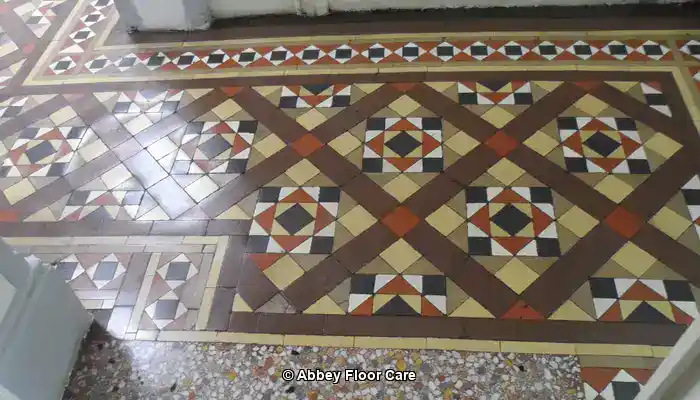
Upon completing the cleaning process and removing old topical sealers, the floor was sealed with an LTP Colour Enhancing Impregnating sealer. The surface was further protected with a carefully applied wax, seamlessly integrating the clay tiles into the historic fabric of the building while preserving their integrity and beauty.
Dedication to Preserving Heritage Through Expert Restoration Practices
Restoring the colour and pigment of Victorian mosaic tiles involves a complex interplay of material science, craftsmanship, and respect for heritage values. Utilizing premium impregnating colour-enhancing sealers from industry leaders such as Dry Treat, Lantania, and Lithofin guarantees long-term breathability, protection, and colour vibrancy. Skilled cleaning, careful repair, and ongoing maintenance are essential in upholding authenticity while rejuvenating these historic floors for future generations to appreciate and enjoy.
Frequently Asked Questions About Victorian Mosaic Tile Restoration
What Are Victorian Mosaic Tiles?
Victorian mosaic tiles are decorative tiles that rose to prominence in the 19th century, recognized for their vibrant colours and intricate patterns. They were commonly utilized in public buildings and private homes, showcasing the artistic flair of the period.
How Can I Effectively Restore Faded Victorian Mosaic Tiles?
Restoring faded Victorian mosaic tiles involves a comprehensive process that includes cleaning, repairing damages, applying new pigments to match the original colours, and subsequently sealing the tiles to protect them from future wear and fading.
Which Materials Are Essential for Tile Restoration?
Essential materials for tile restoration encompass specialized cleaning solutions, pigments, adhesives, grout, and protective sealants, all selected for compatibility with the original tiles to ensure a harmonious and effective restoration process.
How Long Does the Tile Restoration Process Typically Take?
The duration of tile restoration can vary significantly based on the size and condition of the area being restored, typically ranging from a few days for smaller projects to several weeks for more extensive restorations, ensuring thorough and meticulous work.
Can I Undertake the Restoration Myself?
Yes, smaller restoration projects can be approached as DIY tasks if you possess the necessary skills and tools. However, more complex repairs generally require professional expertise to ensure quality results and to avoid potential damage to the tiles.
What Is the Estimated Cost of Restoring Victorian Mosaic Tiles?
Costs can vary widely based on project size and condition, ranging from a few hundred to several thousand pounds for comprehensive restorations, reflecting the level of detail and care involved in the process.
How Do I Select the Right Restoration Expert for My Tiles?
Look for restoration professionals with experience in historical projects, positive reviews, and a commitment to using authentic materials and techniques, ensuring that your restoration is in capable and knowledgeable hands.
What Challenges Do Restorers Commonly Encounter?
Restorers frequently face challenges such as matching original colours, repairing damaged tiles, and ensuring the longevity of the restoration work, requiring both skill and a deep understanding of the materials involved.
How Can I Effectively Maintain My Restored Tiles?
Regular cleaning with pH-neutral products, avoiding harsh chemicals, resealing periodically, and promptly addressing any damage are key strategies for maintaining restored tiles in optimal condition and ensuring their longevity.
What Innovations Are Currently Influencing Tile Restoration Practices?
Recent innovations encompass advanced cleaning solutions, new types of sealants, and digital technology for precise colour matching and pattern replication in restoration projects, significantly enhancing the effectiveness and accuracy of restorations.
The Article Restoring Colour and Pigment to Faded Victorian Mosaic Tiles first found on https://www.abbeyfloorcare.co.uk
The Article Restoring Victorian Mosaic Tiles: Reviving Colour and Pigment appeared first on https://fabritec.org
The Article Restoring Victorian Mosaic Tiles: Revive Colors and Patterns Was Found On https://limitsofstrategy.com

